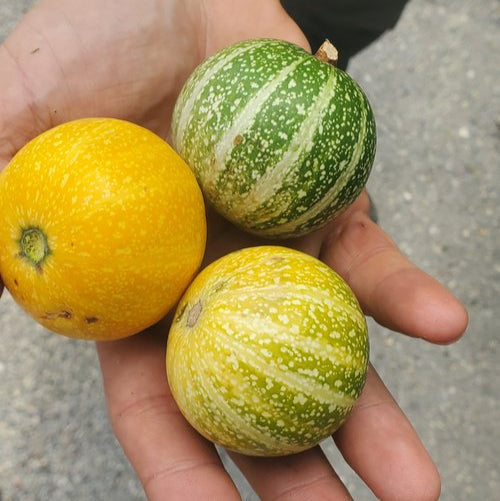Love it? Add to your wishlist
Your favorites, all in one place. Shop quickly and easily with the wishlist feature!
[message]
[title]
[message]


Veliyath Gardens
Couldn't load pickup availability
For collectors of rare fruiting vines and admirers of botanical treasures, Cionosicys excisus is an unparalleled addition. This exotic species from the Yucatán Peninsula and parts of Chiapas and Guatemala carries an air of mystery, as it has no widely used common name in English. However, its uniqueness is not limited to its identity—it extends to its taste, growth habit, and cultural origin.
This elusive member of the Cucurbitaceae family, though little known outside Central America, has captured the attention of tropical plant enthusiasts for its sweet, milky fruits and fascinating perennial root system.
Botanical Name: Cionosicys excisus
Common Name: No widely used English common name
Native To:
Yucatán Peninsula, Mexico
Chiapas, Southern Mexico
Guatemala
This cucurbit vine thrives in the dry forests and tropical zones of Mesoamerica and is considered endemic to the Yucatán region, with cultural and ecological significance in its native zone.
One of the most intriguing features of Cionosicys excisus is its growth pattern. Unlike typical vines, it develops a large underground tuber that stores energy during dormancy and revives with new growth annually.
Grows as a perennial vine with seasonal dormancy
Forms a large, drought-tolerant tuber underground
Produces tendrils and climbing branches ideal for trellises
Ideal for tropical to sub-tropical climates
This tuber helps it survive dry or cool seasons by retreating into dormancy, making it remarkably resilient for a vine species.
The fruit of Cionosicys excisus, while visually modest, offers a distinctive flavour that surprises first-time tasters.
Must be fully ripe for consumption
Taste: Extremely sweet with a mild, milky essence
Texture: Smooth and slightly juicy, with tender flesh
Best Consumed Fresh, soon after harvesting
Its sweetness is comparable to cane sugar, with a creamy undernote that makes it suitable for fresh consumption or light dessert applications.
Although formal nutritional analysis is limited due to the fruit’s rarity, traditional use and genus-related properties suggest several natural benefits:
Likely contains natural sugars and plant-based carbohydrates
May provide mild hydration and energy due to its water and sugar content
Tuber may offer starch reserves, a trait seen in other cucurbits
Traditionally considered a cooling fruit in local use, helping to relieve fatigue
Its fruit and tuber are valued not only for sustenance but also for survival and regeneration in arid zones, symbolizing endurance and renewal.
In rural areas of Yucatán and Guatemala, Cionosicys excisus may be gathered from the wild and consumed when in season. Although not cultivated widely, its presence in the natural diet reflects its role in subsistence foraging and seasonal feasting.
Fruit is consumed fresh by locals during late ripening season
The tuber is occasionally recognized for its life-sustaining capacity
In some parts of Mexico, such fruits are used during festive months when wild produce is integrated into traditional meals
Its unique ability to disappear and reappear with seasons makes it a living symbol of nature’s cycle.
Growing Cionosicys excisus is an exciting venture for gardeners who appreciate vines that offer both botanical intrigue and delicious harvests.
Requires well-draining soil and a warm environment
Best grown in large containers or open ground with trellis support
Needs adequate sun exposure, but partial shade is tolerated
During dormancy, reduce watering and keep the tuber dry
In spring or with warmth, new shoots emerge naturally
Once established, the vine will regrow each year, rewarding the grower with seasonal beauty and rare fruit.
Given its sugar-rich taste, this fruit is best enjoyed fresh when it reaches full maturity. However, creative gardeners and culinary explorers might find new ways to use it.
Freshly eaten, like a tropical candy
Can be chilled or added to fruit platters
May complement mild tropical desserts
Syrup or pulp could be explored in experimental jams or smoothies
Its delicate taste does not call for elaborate preparation—simplicity is the key to savoring this fruit.
Because of its perishability and soft nature, Cionosicys excisus should be handled with care.
Consume immediately after ripening
May be stored briefly in a cool, dry place
Refrigeration can preserve freshness for 1–2 days
Tuber should be stored dry during dormancy to prevent rot
Preservation methods are limited, but the fruit’s charm lies in its seasonal and ephemeral nature.
An interesting fact for collectors and researchers: there is another Cionosicys species native to Panama, hinting at the genus's broader biodiversity. The potential to hybridize these two species offers exciting prospects for horticultural innovation.
With its sweet, milky fruit, rare origin, and dramatic growth cycle, Cionosicys excisus is a treasure for plant collectors and food explorers alike. Its tuberous growth, cultural connection to Central America, and sugar-like flavour make it a remarkable addition to a home garden or specialty orchard.
Veliyath Gardens offers healthy, well-rooted Cionosicys excisus live plants for those seeking to grow something truly unique. For anyone who appreciates plants that tell a story and reward with flavor, this vine is an investment in curiosity and taste.
Requires well-draining soil and a warm environment
Best grown in large containers or open ground with trellis support
Needs adequate sun exposure, but partial shade is tolerated
Likely contains natural sugars and plant-based carbohydrates
May provide mild hydration and energy due to its water and sugar content
Tuber may offer starch reserves, a trait seen in other cucurbits
Grows as a perennial vine with seasonal dormancy
Forms a large, drought-tolerant tuber underground
Produces tendrils and climbing branches ideal for trellises



